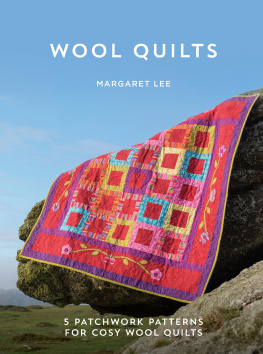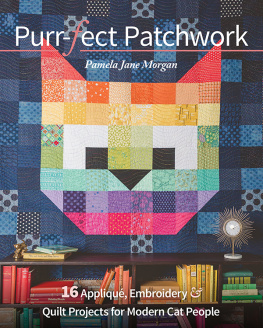Dedication
This book is dedicated to all the modern quilters out there who are doing their own thing and creating something beautiful.
Acknowledgments
Thank you to my husband, Chris Hartman, for his support of this project, and to my Portland sewing circle for making the past year so much fun.
Thank you to everyone at C&T Publishing for all your hard work in making this book a reality.
Thank you also to Robert Kaufman Fabrics, Cloud9 Fabrics, Daisy Janie, and Art Gallery Fabrics for generously providing me with fabric to use for this book, and a huge thank-you to Jill Collins for her help with drafting the template patterns.
Introduction
I consider myself a modern quilter, which is sometimes hard to define. In the simplest terms, I think it means that I embrace a clean, modern aesthetic and that Im more concerned about what works for me than about following a previously established set of rules.
These days its not hard to find patterns for modern quilting. Many of these are promoted as being quick and simple, which has drawn criticism from some traditionalists. While I disagree that modern quilting is by nature simplistic and unstructured, there does seem to be a dearth of more challenging patterns for modern quilters. Some suggest that modern quilters should just make traditional blocks instead. Thats a fine idea in theory, but what if we dont care for the look of traditional blocks? What if we want to make something stylish that we can use in our homes now?
I firmly believe that expanding your skills and taking on new challenges doesnt necessarily mean making traditional blocks. My goal with this book has been to create a set of modern patterns for intermediate-level quilters that promote precision piecing and thoughtful fabric selection, introduce new challenges, andmost importantproduce beautiful, stylish quilts that will fit into your modern home.
If youre fairly new to quilting, some of the projects in this book may involve techniques that you havent tried before or more precise piecing than youre used to. Dont let that scare you off! Making a quilt takes time and, often, trial and error. Creating a beautiful quilt that you can use for years to come is worth the effort!
If you are a beginner or need a refresher course on quiltmaking basics, refer to Materials, Supplies, and More (). For more information, my book The Practical Guide to Patchwork provides everything else you might need to know.

Metropolis
Finished block: 15 15 Finished quilt: 75 75 Made and machine quilted by Elizabeth Hartman
Blocks are sewn and sliced and sewn and sliced again for this quilt top, resulting in a striking woven look that is intricate without being fussy. Setting the blocks in a sea of neutral fabric gives the impression of artwork hanging in a gallery, while the quilt back features an eye-popping giant version of the single block.

Selecting the Fabric
I started with three multicolor prints that include cream, sea green, gold, gray, and chocolate brown. Then I filled out my selection with six coordinating monochromatic print and solid fabrics that highlight the multicolor prints without overpowering them or making the composition too busy.
Refer to Fabric and Design Vocabulary () for more about fabric selection.

My fabric choices for Metropolis
tip
When choosing a solid fabric to coordinate with a print, focus more on highlighting the colors in the print than on trying to match them exactly. Sometimes a solid fabric that is slightly different is more visually interesting.
materials
Yardages are based on fabric that is at least 40 wide, unless otherwise noted.
2 yards dark sea green solid fabric (Fabric 1)
2 yards light sea green solid fabric (Fabric 2)
yards light sea green solid fabric (Fabric 2)
yard gold solid fabric (Fabric 3)
1 yards multicolor print fabric #1 (Fabric 4)
yards multicolor print fabric #1 (Fabric 4)
 yard medium brown print fabric (Fabric 5)
yard medium brown print fabric (Fabric 5)
 yard multicolor print fabric #2, at least 42 wide (Fabric 6)
yard multicolor print fabric #2, at least 42 wide (Fabric 6)
1 yards chocolate brown print fabric (Fabric 7)
yards chocolate brown print fabric (Fabric 7)
1 yards multicolor print fabric #3 (Fabric 8)
2 yards chocolate brown solid fabric (Fabric 9)
3 yards neutral solid sashing fabric
yards neutral solid sashing fabric
 yard binding fabric
yard binding fabric
79 79 batting
Stick-on labels
cutting instructions
tip
Take a moment and use the stick-on labels to label each fabric with its number (1 through 9), as listed in the materials list. As you cut, transfer the labels to the corresponding stacks of block units. Label the 41 pieces for the quilt back as you cut them, using the unique code indicated in the cutting instructions (1A, 2B, and so on).
FABRIC 1 (DARK SEA GREEN SOLID):
Cut:
2 strips 22 width of fabric; subcut into:
1 piece 22 22 (1A)
1 piece 18 22 (1D)
1 piece 13 22 (1C)
2 pieces 5 22 (1B and 1I)
1 piece 4 22 (1E)
1 strip 4 width of fabric; subcut into:
1 piece 18 4 (1H)
1 piece 13 4 (1G)
1 piece 5 4 (1F)
1 strip 5 width of fabric; subcut into:
1 piece 18 5 (1L)
1 piece 13 5 (1K)
1 piece 5 5 (1J)
Set all the above pieces aside for the quilt back.
2 strips 11 width of fabric; subcut into 9 pieces 6 11 (Block Unit 1), and set these aside for the quilt blocks
FABRIC 2 (LIGHT SEA GREEN SOLID):
Cut:
2 strips 18 width of fabric; subcut into:
1 piece 18 18 (2H)
1 piece 13 18 (2G)
1 piece 5 18 (2F)
1 piece 22 18 (2E)
2 strips 5 width of fabric; subcut into:
1 piece 18 5 (2D)
1 piece 13 5 (2C)
1 piece 5 5 (2B)
1 piece 22 5 (2A)
Set all the above pieces aside for the quilt back.
2 strips 11 width of fabric; subcut into 9 pieces 4 11 (Block Unit 2) and set these aside for the quilt blocks
FABRIC 3 (GOLD SOLID):
Cut:
2 strips 6 width of fabric; subcut into:
1 piece 18 6 (3D)
1 piece 10 6 (3C)
1 piece 4 6 (3B)
1 piece 22 6 (3A)
Set these aside for the quilt back.
3 strips 1 width of fabric; subcut into 9 pieces 11 1 (Block Unit 3) and set these aside for the quilt blocks
FABRIC 4 (MULTICOLOR PRINT #1):
Cut:
2 strips 15 width of fabric; subcut into:
1 piece 33 15 (4A)
1 piece 18 15 (4C)
1 piece 13 15 (4B)
Set these aside for the quilt back.
1 strip 12 width of fabric; subcut into 9 pieces 3 12 (Block Unit 4) and set these aside for the quilt blocks

















 yards light sea green solid fabric (Fabric 2)
yards light sea green solid fabric (Fabric 2) yards multicolor print fabric #1 (Fabric 4)
yards multicolor print fabric #1 (Fabric 4) yard medium brown print fabric (Fabric 5)
yard medium brown print fabric (Fabric 5) yard multicolor print fabric #2, at least 42 wide (Fabric 6)
yard multicolor print fabric #2, at least 42 wide (Fabric 6)